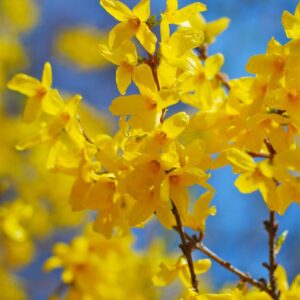Showing the single result
Everything You Need to Know about Forsythia Suspensa
Cold Stream Farm has a limited supply of Forsythia (Forsythia Suspensa), which has many many different common names. You may know the species as forsythia, forsythia Lynwood, Lynwood gold, golden bell, border forsythia, Lynwood variety, or other nicknames.
Our border forsythia plants are a hybrid species that have been widely popularized throughout the world. Forsythia Suspensa is a great low-maintenance border shrub that produces striking gold flowers.
Size and Appearance
A mature golden bell plant will typically reach between six and ten feet tall with an average spread ranging from six and eight feet wide. Forsythia shrubs are easily recognizable when in bloom with bright golden-yellow flowers produced in wide bell-like clusters.
The branches of border forsythia shrubs tend to grow very thickly from the central trunk. As a cultivated species, it is most common to see forsythia shrubs planted either ornamentally as a lone specimen or next to one another in a hedge, border, or windbreak.
Ideal Growing Conditions for Lynwood Gold
Lynwood gold (border forsythia) grows best in USDA hardiness zones 5, 6, 7, or 8. Within these areas, the plant is quite tolerant of droughts as well as a variety of soil and climate conditions. For the best results, forsythia thrives in moist, well-drained soils.
Forsythia Suspensa can be grown in both full sun and partial shade. In order for the plant to flower and grow to its full potential, Lynwood gold transplants are best placed in areas that receive sunlight throughout the entire day.
How to Plant Border Forsythia Shrubs
As mentioned above, border forsythia shrubs are very low maintenance plants, which makes them perfect for public spaces or gardens without significant upkeep. The species grows very fast and plants tend to live long, healthy lives throughout ordinary climate conditions.
Border forsythia shrubs can be planted nearly any time of the year, with most success best assured during spring transplanting. If you are planting a solitary golden bell plant, then you will want to allow for about ten feet of total spread. When planted next to one another in a hedge, border forsythia shrubs can be placed within feet from one another, depending on the desired effect and current vegetation.
One Year as a Forsythia Shrub
Blooming in early spring, the bright flowers of border forsythia are typically the first feature to populate the branches each year. The bright gold flowers may begin as early as the first or second year of a plant’s life, slowly increasing the number of blooms produced each spring.
Once the flowers have faded and the stocks start to show signs of drooping, it is recommended that forsythias are trimmed in the late spring. Pruning early, rather than in the summer or fall, will help propagate more flowers in the next year’s bloom.
Shortly after the bloom, dark green oval leaves begin to bud on forsythia branches, with adult plants bearing leaves up to 3 inches long. The leaves turn to yellow in the fall with tinges of purple to round out a full year of interesting landscape colors.
Wildlife Interaction and Ecology
Unlike many other colorful shrubs, border forsythia plants are very deer resistant and tend to not be picked apart by birds or mammals. As an introduced species, golden bell plants are somewhat susceptible to a number of infestations from mites, aphids, and other small insects.
Although they are low maintenance plants, annual inspections of forsythia shrubs for signs of crown gall or leaf spotting are recommended. Fertilization may be necessary for young or sick plants, but the species does quite well without it. In fact, over-exposure to nitrogen may limit forsythia blooms.
Interesting Facts about Forsythia Shrubs
The Royal Horticultural Society has recognized Lynwood variety border forsythia with the Award for Garden Merit for its success throughout the United Kingdom’s gardens, parks, and other green spaces. Of course, this may be slightly biased, as forsythia derives its name from William Forsyth, who is one of the Royal Horticultural Society’s founders.
Forsythia plants are native to China and have been used in traditional Chinese medicine to aid colds, ailments, and fevers. Scientifically, the shrubs are actually classified in the olive (Oleaceae) family.
Order forsythia shrubs with Cold Stream Farm.
Cold Stream Farm carries most of our border forsythia supply in the spring, with some transplants available all year long. There is no minimum order through our online shop, and customers may feel free to contact Cold Stream Farm during weekday business hours with questions about shipping considerations for wholesale and retail orders.


